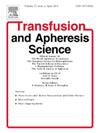The effect of threosulfan-based versus busulfan-based preparation regimens on transplant outcomes
IF 1.2
4区 医学
Q4 HEMATOLOGY
引用次数: 0
Abstract
Background
Allogeneic hematopoietic stem cell transplantation is a curative therapy for malignant and non-malignant hematologic disorders. Conditioning regimens, such as those based on busulfan, are utilized to promote engraftment. Busulfan-based regimens are commonly employed but exhibit significant toxicity, leading to interest in alternate drugs such as treosulfan, which may offer a superior safety profile while preserving efficacy.
Methods
This retrospective study examined 240 adult patients diagnosed with acute myeloid leukemia or acute lymphoblastic leukemia who received allogeneic hematopoietic stem cell transplantation at nine transplantation centers in Türkiye from 2010 to 2024. Patients underwent either a busulfan-based or treosulfan-based conditioning regimen.
Results
Engraftment was effective in both groups, with neutrophil engraftment happening earlier in the busulfan group (13 days vs. 15 days, p = 0.001). The incidence of veno-occlusive disease was significantly higher in the busulfan group (10.1 % vs. 0.9 %, p = 0.002). Cytomegalovirus infections were more prevalent in the busulfan group (51.2 % vs. 26.1 %, p < 0.001). Acute graft versus host disease occurred more frequently in the busulfan group (27.9 % vs. 18.9 %, p = 0.128); nonetheless, this difference did not reach statistical significance. No significant differences in relapse rates were detected through the groups. The overall survival was not reached in the busulfan group, while the treosulfan group demonstrated an overall survival of 40 months.
Conclusion
Treosulfan-based conditioning regimens demonstrate similar efficacy to busulfan-based regimens while presenting a more acceptable toxicity profile. Treosulfan-based regimens also show a lower occurrence of veno-occlusive disease and cytomegalovirus infections.
基于磺磺胺和基于丁磺磺胺的制剂方案对移植结果的影响
异体造血干细胞移植是一种治疗恶性和非恶性血液疾病的有效方法。调理方案,如那些基于蒲士丹,被用来促进植皮。以布硫丹为基础的治疗方案通常被采用,但表现出明显的毒性,导致人们对曲硫丹等替代药物的兴趣,这些药物可能在保持疗效的同时提供更高的安全性。方法回顾性分析2010年至2024年在中国9个移植中心接受同种异体造血干细胞移植的240例确诊为急性髓性白血病或急性淋巴细胞白血病的成年患者。患者接受以布硫丹为基础或以曲硫丹为基础的调理方案。结果两组移植均有效,布苏凡组中性粒细胞移植发生较早(13天比15天,p = 0.001)。布苏凡组静脉闭塞性疾病的发生率明显高于对照组(10.1 % vs. 0.9 %,p = 0.002)。巨细胞病毒感染在布苏凡组更为普遍(51.2% % vs. 26.1% %,p <; 0.001)。布苏凡组的急性移植物抗宿主病发生率更高(27.9 % vs. 18.9 %,p = 0.128);然而,这种差异没有达到统计学意义。两组复发率无显著差异。布硫丹组没有达到总生存期,而曲硫丹组的总生存期为40个月。结论以曲硫丹为基础的调理方案与以布硫丹为基础的方案具有相似的疗效,但具有更可接受的毒性特征。以曲硫丹为基础的治疗方案也显示出较低的静脉闭塞性疾病和巨细胞病毒感染的发生率。
本文章由计算机程序翻译,如有差异,请以英文原文为准。
求助全文
约1分钟内获得全文
求助全文
来源期刊
CiteScore
3.60
自引率
5.30%
发文量
181
审稿时长
42 days
期刊介绍:
Transfusion and Apheresis Science brings comprehensive and up-to-date information to physicians and health care professionals involved in the rapidly changing fields of transfusion medicine, hemostasis and apheresis. The journal presents original articles relating to scientific and clinical studies in the areas of immunohematology, transfusion practice, bleeding and thrombotic disorders and both therapeutic and donor apheresis including hematopoietic stem cells. Topics covered include the collection and processing of blood, compatibility testing and guidelines for the use of blood products, as well as screening for and transmission of blood-borne diseases. All areas of apheresis - therapeutic and collection - are also addressed. We would like to specifically encourage allied health professionals in this area to submit manuscripts that relate to improved patient and donor care, technical aspects and educational issues.
Transfusion and Apheresis Science features a "Theme" section which includes, in each issue, a group of papers designed to review a specific topic of current importance in transfusion and hemostasis for the discussion of topical issues specific to apheresis and focuses on the operators'' viewpoint. Another section is "What''s Happening" which provides informal reporting of activities in the field. In addition, brief case reports and Letters to the Editor, as well as reviews of meetings and events of general interest, and a listing of recent patents make the journal a complete source of information for practitioners of transfusion, hemostasis and apheresis science. Immediate dissemination of important information is ensured by the commitment of Transfusion and Apheresis Science to rapid publication of both symposia and submitted papers.

 求助内容:
求助内容: 应助结果提醒方式:
应助结果提醒方式:


